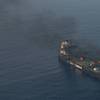Ship Disposal Encounters Enviro, Political Hurdles
By Joan M. Bondareff and Charles T. Blocksidge
In 2001, Congress directed the Maritime Administration (MarAd) to dispose of all obsolete vessels in its inventory by September 30, 2006, and to do so "in the manner that provides the best value to the Government." At present, MarAd has 104 non-retention ships not under contract in three locations around the country-James River Reserve Fleet in Virginia, Beaumont Reserve Fleet in Texas, and Suisun Bay Reserve Fleet in California. MarAd is using a variety of ship disposal options, which include domestic and foreign dismantling/recycling to accomplish this directive. Both have been controversial and foreign scrapping has prompted litigation. This article describes what MarAd is doing and what laws are implicated in this mission.
The U.S. Government historically has exported its obsolete vessels to foreign ship breakers and was paid approximately $100 per ton for the scrap steel recovered from these ships. Between 1983 and 1994, approximately 200 obsolete vessels wound up in such facilities. In the late 1990's, a series of Baltimore Sun newspaper articles introduced the world to the shipbreaking industry and focused its attention on the deplorable health and environmental conditions that went hand-in-hand with this necessary resource reclamation function. In particular, the articles focused on Alang, India. Alang has a six mile stretch of beach abutting the Arabian Sea, where impoverished workers labor without the tools of modern industry to break ships for what amounts to $2 to $3 a day. The ships are basically ripped apart by hand with apparent disregard for the Polychlorinated Biphenyls (PCBs), asbestos and lead paint that is prevalent in older ships. Based on these articles and discovery of PCBs in shipboard components, the U.S. Government decided to stop the exportation of government owned ships until a safer and more environmentally sound solution could be found. With the foreign markets no longer an option, MarAd began more aggressively selling its ships for domestic breaking. Very few traditional shipyards bid on the offer and the U.S. Government grew concerned that this was based on insufficient capacity. In the end, capacity played less of a factor than lack of U.S. shipyard interest. To help MarAd meet its statutory deadline, Congress intervened and created a new pilot program that allows MarAd to export obsolete ships and explore the feasibility of additional alternatives for exporting more ships from the National Defense Reserve Fleet (NDRF).
Some U.S. companies continue to bid to dispose of the vessels in the so-called "Ghost Fleet," including D&D Steel, International Shipbreaking, Esco Marine, Bay Bridge Enterprises, and Resolve Marine Group, to name a few. As MarAd has moved from an all foreign to a mixed foreign and domestic sales strategy, the agency has had to comply with various U.S. laws and international conventions, and, unfortunately, controversy has continued to dog the program.
U.S. Law and Policy
Domestic laws and international treaties both control aspects of ship dismantling and recycling. These include the Clean Water Act (CWA), the Toxic Substances Control Act (TSCA), and the Basel Convention.
Over the past several years, there have been a few incidences of residual oil and fuel discharges into U.S. waters prompting domestic environmental concerns. The ramifications of this leaking not only suggest potential enforcement under the CWA, but also have prompted increased calls by the residents of Virginia for the ships' removal. These vessels have been stored in the James River since 1924. The CWA establishes the basic structure for regulating discharges of pollutants into the waters of the U.S. and gives Environmental Protection Agency (EPA) the authority to implement pollution control programs setting wastewater standards for industries. The Act also makes it unlawful to discharge any pollutant from a point source into navigable waters.
MarAd commissioned a study to determine the extent of the discharges. In the worst case scenario, MarAd determined that if two ships in the James River Reserve Fleet broke apart, 50 miles of shoreline would likely be contaminated and clean-up costs could exceed $40 million. Concerns of the residents of Virginia and MarAd's pursuit of attractive export proposals, prompted Congress to enact the pilot program, described above, allowing the export of ships as long as environmentally safe procedures were implemented to remove the ships from their current moorings.
TSCA regulates the domestic introduction and use of new and old chemicals. TSCA specifically bans the introduction of PCBs and regulates all usage of PCBs in amounts higher than 50 parts per million. Under TSCA, the US cannot export PCBs in regulated quantities. Through a court decision and US policy, the export of a vessel containing PCBs in banned amounts has been construed to be an export regulated under TSCA.
The U.S. has signed but not ratified the Basel Convention. The Convention restricts the transfer or transboundary movements of hazardous wastes. In addition, the Convention calls for the treatment and disposal of hazardous wastes as close as possible to their source of generation. There is no international consensus whether the Basel Convention applies to the exports of ships. However, some countries and some Non-Governmental Organizations (NGO) believe that it does.
MarAd Program
MarAd is working diligently to meet the 2006 Congressional deadline. The agency is using three approaches to compliance: (1) vigorous pursuit of a combination of domestic and foreign recycling, artificial reefing, deep sinking, vessel donation and vessel sales; (2) using a new procurement tool called a Program Research and Development Announcement (PRDA) in addition to traditional procurement methods; and (3) implementing the pilot program to allow exportation of the obsolete ships.
The PRDA allows MarAd to sell ships and to procure dismantling services from either foreign or domestic ship recycling facilities that provide the best value to the Government. Each proposal submitted under the PRDA is evaluated based on environmental considerations, worker safety and cost assessments. The advantages of the PRDA are the discovery of innovative approaches to ship dismantling and recycling and the ability for MarAd to find a long-term solution for the removal of ships from the NRDF. The PRDA has resulted in increased competition, access to greater industrial capacity, lower disposal costs, and increased rate of vessel disposals.
The pilot program allows MarAd to explore the exportation of obsolete ships with the confidence that the funding will be available to complete the transactions accepted from the PRDA proposals. To facilitate the pilot program, in May 2003, EPA issued an "enforcement discretion" letter stating that even though ships contain PCBs, they may be transferred to the AbleUK facility in the United Kingdom provided that MarAd removes all readily removable PCBs prior to exportation and issues a declaration to the importer concerning any hazardous materials that may be found on the vessel.
In July 2003, MarAd awarded a $14,846,338 contract to AbleUK, of Teesside England to dismantle thirteen ships under the pilot program. Of these, eleven are on MarAd's forty worst list of ships built between 1945 and 1965. The AbleUK proposal was deemed acceptable and determined to be a best value to perform this task based on the program's requirements. At the same time, MarAd awarded contracts domestically to Marine Metals of Brownsville, Texas for $414,768: Bay Bridge Enterprises of Chesapeake, Virginia for $2,763,082; ESCO Marine of Brownsville, Texas for $778,837; and Resolve Marine Group of Port Everglades, Florida for $3,465,779 to scrap a total of eight ships. In 2003, twenty-five obsolete NDRF ships were included in disposal contracts awarded to domestic and foreign companies. In the fall of 2003, the first ships were towed from their moorings in the James River to England. Following the transport of the first two ships, the NGO Basel Action Network (BAN) filed suit in the United States District Court for the District of Columbia to stop the transfer of nine other vessels. BAN claimed that the exportation of the vessels violated TSCA--notwithstanding the "enforcement discretion" letter issued by the EPA in May 2003. The Court granted a Temporary Restraining Order against MarAd to prevent them from transferring more than four ships until MarAd prepared an additional Environmental Assessment (EA). A draft EA was issued on February 20, 2004, and comments were due on March 29, 2004.
Concurrent litigation in the U.K. has prevented the commencement of the actual dismantling. The local government initially gave AbleUK permission to dismantle "marine structures," but the High Court of England determined in December 2003 that the ships are not "marine structures." Therefore a new waste management license must be obtained prior to the breaking of the four U.S. ships currently berthed at the Teesside docks. In addition, AbleUK has run into obstacles for gaining permission to modify their existing dry-docking facilities. In the event AbleUK does not succeed in acquiring the necessary licenses, the ships could have to make another transatlantic crossing back to the James River!
Navy Program
The Navy has used several methods to dispose of its obsolete ships: foreign military sale transfers, creation of artificial reefs, experimental/target use, title transfer to MarAd and domestic ship scrapping. The Navy faces the same dilemma as MarAd. The interest of most domestic shipbreaking has waned and the availability of environmentally safe foreign companies is limited, therefore, the Department of Defense must consider acceptable alternatives. The 82 ships that are currently slated for dismantling and recycling cost the Navy approximately $13 million annually for storage, maintenance and security. At present these vessels are in three locations around the country - Pearl Harbor, Hawaii, Bremerton, Washington, and Philadelphia, Pennsylvania. Since the late 1990's, the Navy has exclusively used domestic yards for dismantling. This costs about $500-1000 per ton to scrap which amounts to approximately $2 to $5 million for a combatant and about $60 million for an aircraft carrier. Though the Navy's use of domestic scrappers has been publicly commended by Greenpeace and has won accolades from the Secretary of the Navy, reefing these obsolete ships seems to be the best option. The demand to create artificial reefs off the coast of several states nearly matches the number of ships available for reefing. The only thing holding up this perfect union is the EPA, which has yet to set the environmental standards for such a program. Until the artificial reefing can begin, some domestic facilities are stepping up to the plate such as Metro Machine Corp., Philadelphia; and International Shipbreaking Ltd., Brownsville, Texas.
Conclusions
The U.S. Government, notably MarAd, is under a legal obligation to dispose of its obsolete ships by 2006. The lack of U.S. shipyard interest, combined with budgetary problems, and litigation both here and abroad, have delayed the program. It remains to be seen whether the deadline will have to be further extended.
About the Authors
Joan M. Bondareff currently of Counsel at Blank Rome LLP handles maritime transportation, environmental and legislative issues for the firm. Prior to joining the firm, Ms. Bondareff was Chief Counsel and Acting Deputy Administrator of the Maritime Administration, U.S Department of Transportation. Charles T. Blocksidge, an associate in Blank Rome LLP's Maritime, International Trade and Procurement Practice Group is a former naval officer and focuses on maritime, environmental and regulatory issues. They can be reached at [email protected] and [email protected], respectively.










